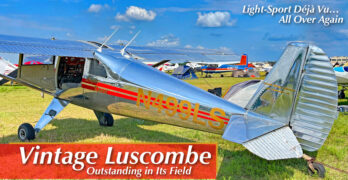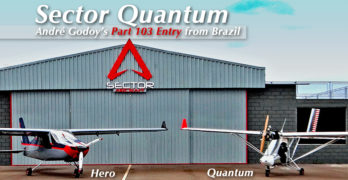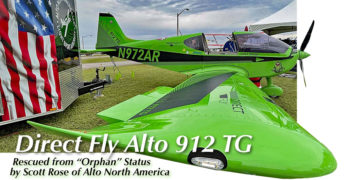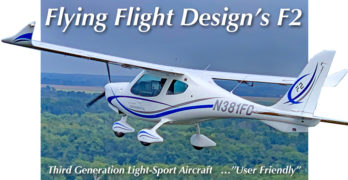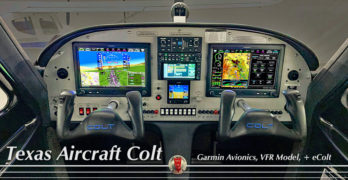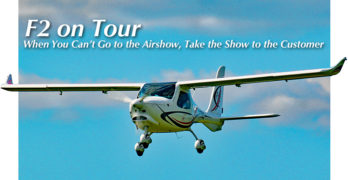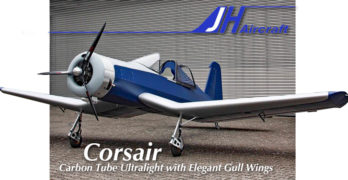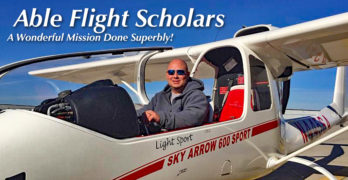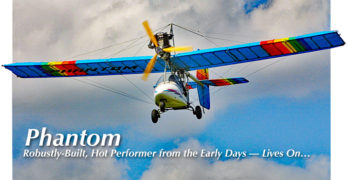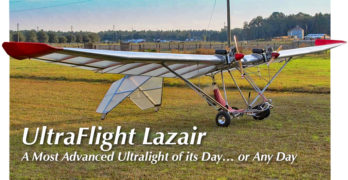Continuing news from Sun ‘n Fun 2021 is rolling in from across the country. Even while most international enthusiasts were unable to attend because of covid-induced travel restrictions, Americans turned out in strong numbers — and had a great time.
FAA personnel casually (not officially) reported some 70,000 tickets bought on Saturday alone. I have no idea about such numbers historically, but by any measure, that’s a darn fine performance, the equivalent of a major football stadium stuffed full of fans. I am so relieved for Sun ‘n Fun. Inc., and I’m sure my relief is but a drop in the bucket compared to that felt by Team Sun ‘n Fun.
If Oshkosh goes similarly, then I think it will be fair to say recreational aviation is nearly back to normal. Fortunately, in the Year of Fear that may be ending, tons of builders worked on kit airplanes, loads of LSA owners got out and flew their birds, and Part 103 ultralights probably set a record for shipments and kept sport pilots up in the air.
Search Results for : flight design ct
Not finding exactly what you expected? Try our advanced search option.
Select a manufacturer to go straight to all our content about that manufacturer.
Select an aircraft model to go straight to all our content about that model.
Quantum Development… Brazilian Part 103 Ultralight Entry Explained by Designer
Welcome to a New Year! …and to a new airplane, a new Part 103 entry to be specific.
One of the most amazing discoveries of 2020 — the year Covid upset lives around the globe — is the particular and peculiar strength of Part 103 ultralights.
In a year that has seen hundreds of thousands of small businesses fail under the pressure of executive orders, and the lockdown of an amazing percentage of the world’s individuals, the littlest airplanes have found new life.
Are you surprised? I was… despite being a fan of Part 103s for several decades.
What will happen in 2021 and beyond? No one has a crystal ball but I am going to guess that we will continue to see strength in the 103 segment for one primary reason: affordability.
You Can Afford
Your Own Aircraft
FAA’s Part 103 is an American phenomenon, dating to 1982, when the nearly 40-year-old regulation was issued.
Direct Fly Alto LSA — It’s Back with All its Sweet-Flying Qualities (Ghostbuster Optional)
Back when Light-Sport Aircraft were still youngsters in aviation (LSA are teenagers now), Ron Corbi imported the Direct Fly Alto 100. In those early days, competition was fierce and only a few of the nearly 100 manufacturers who entered the race were able to rise into the top 20 best-selling brands.
Then, life got more complicated for Ron and he chose to quietly bow out of representing Alto.
However, Czech Republic producer Direct Fly never stopped. Indeed, the company has supplied more than 80 aircraft to dealers in places as close as Europe and as distant as Australia.
Given the deluge of handsome LSA offered to Americans, Alto slipped off the radar for most Yankee pilots but not before Ron demonstrated the design’s worthy qualities. Check this video with Ron regarding a flight school using Alto 100.
As we prepare to start the third decade of the new millennia, learn more by visiting Alto North America.
Third Generation Flight Design — Flying the New F2 at Midwest LSA Expo 2020
➡️ Update 11/3/20 — A new video interview with Flight Design USA importer Tom Peghiny appears at the bottom of this article. —DJ
In the beginning — as Light-Sport Aircraft entered the skies for the first time — German producer Flight Design brought the CTSW to American pilots. It was embraced enthusiastically and the U.S. importer Flight Design USA sold many units to aviators that had waited years for FAA to finalize their no-medical-required LSA segment. CTSW was something of a sports car, agile, quick, high performing but surprisingly roomy.
Then came the sophisticated CTLS, wholly redone for the American market. It enlarged the cabin and lengthened the fuselage becoming more deluxe throughout.
Now, we come to F2 in what I’m calling the third generation of the iconic shape that still leads the LSA market after almost 17 years. The one and only example presently in America is currently based at Airtime Aviation in Tulsa, Oklahoma.
Texas Aircraft and the Colt — Expanding the Light-Sport Aircraft in Several Directions
I always enjoy when a new airplane company arrives on the market and sets plans in motion to expand and improve their flying machine. Texas Aircraft and their Colt 100 Light-Sport Aircraft is one such company.
Lead by the energetic and ambitious Matheus Grande, Texas Aircraft is moving on several fronts. Here is some update on the Colt builder based in Hondo, Texas.
Garmin IFR Colt
“Wait,” I hear some of you exclaim! “A Light-Sport Aircraft cannot be used for flying with reference only to instruments.” Wrong!
Rather than repeat what I have already written several times, I invite you to explore this article which makes an attempt to explain the situation surrounding IFR or IMC, that is, flight in actual instrument conditions; different from filing to fly in the IFR system for training or other reasons.
Certainly, most readers will see the value in a new, modern, fuel efficient, comfortable, and marvelously-equipped Light-Sport Aircraft versus a 30-50 year-old Cessna 172 or other legacy general aviation aircraft.
Flight Design’s F2 Light-Sport Aircraft on Tour — Bringing the “Airshow” to the People
Although a mirror reflection of the greater global economy, many pilots are stunned that airshow after airshow has fallen to the virus. It seems like two or three years ago when, back in February 2020, Videoman Dave and I covered the Copperstate/Buckeye show west of Phoenix.
Here’s another sure sign of virus-induced time distortion. This year, 2020, was the first year that the Sebring U.S. Sport Aviation did not happen after a good run of 15 years. Yes, only seven months ago, many of us would’ve been heading to Sebring, Florida.
Little did we know in those carefree times what cataclysm was to follow starting in March 2020.
When cut off from usual routines, what does an inventive entrepreneur do?
Take to the Air!
Tom Peghiny, the veteran importer of the most successful LSA brand in America, has a new nose-to-tail, winglet-to-winglet Light-Sport Aircraft to show airshow attendees …except he can’t.
All Carbon Fiber (Structure) Part 103 Ultralight Aircraft — Corsair is Coming to America
Most ultralight aircraft (officially: “ultralight vehicles”) are rather simple constructions. They must be to stay within the tight constraints of a 254-pound maximum empty weight.*
That’s not a negative comment about them. Actually, it’s the opposite.
To build a flying airplane that weighs less than the engine alone on a Light-Sport Aircraft, a designer has to be unusually clever.
All aircraft are constrained in weight by the laws of physics. Ultralights are further constrained by regulation.
A key way to keep an aircraft light is to keep it simple. Indeed most 103 ultralights are quite basic. However, as years passed some engineers have found intriguing solutions. I recently wrote about the composite Swan. Why not one using extensive carbon fiber?
Carbon Corsair
German developer Jörg Hollmann took a different approach, one that consumed a few years of effort.
He wanted an aircraft that resembled the famous World War II F4U Corsair fighter.
High Value Mission — Flight Training that Meets Special Requirements in Light-Sport Aircraft
American are very gracious with their donations to good causes. Charitable giving in the USA exceeded $400 billion in 2018 alone. Even during uncertain times as the world currently find itself, Americans still prove surprisingly generous. It makes me proud.
I’ve joined in when it comes to Able Flight, having on several occasions given money to Able Flight. For a pilot, I cannot comprehend how a fellow aviator can ignore this worthy effort, lead by founder and main man Charles Stites. He has single-handedly generated funds from numerous donors, found Light-Sport Aircraft with hand controls, lead the effort to select wonderful scholarship winners, and donated so many of his own hours that I’ll bet he can’t even add them up …for sure, it’s a lot of time invested.
You have many, many great organizations you can support but this one, for pilots anyway, should hit very close to home.
Ultralight April 2020 — Seventh in the Vintage Series: Ultralight Flight Phantom
When the Phantom was introduced to the ultralight market at Sun ‘n Fun in 1982, it won the Best New Design award, not only for good looks and strong performance but for its structural integrity! Indeed, it was touted as having been tested to +9 and –6.6 Gs. Though dismissed by some pilots, wire-braced designs are actually very tough.
Phantom is a kit built from anodized aluminum tubing, bolted and riveted together. The wings, tail surfaces and ailerons are covered in Dacron sail cloth envelopes and Phantom used a double surfaced wing for better cross wind control and handling.
A wire-braced, high-wing, tricycle-gear ultralight aircraft in a tractor configuration, Phantom has a pilot pod with windscreen and a steerable nosewheel. (These were not common in those early days of ultralight vehicles.) Controls are standard stick and rudder — a left hand throttle and right hand joystick — with full span ailerons.
Ultralight April 2020 — Sixth in the Vintage Series: UltraFlight Lazair
The first time I ever saw Lazair fly — a fly-in at the Tullahoma Airport, as I recall — a then-young Peter Corley flew the lightweight aircraft as though he was the pilot of a military fighter of the day. He pushed the sleek machine with the whining engines as he looped and rolled the machine with such apparent ease. At this early time of development for these aircraft, such maneuvers in what we called an ultralight were very unusual.
To say either Peter or Lazair was unusual proved something of an understatement. Lazair was, and remains, one of the most unorthodox aircraft of any kind. Several reasons stand out to define its uniqueness.
These differences included: an inverted-V tail, said to be the most efficient tail planform; twin engines (the tiniest ones imaginable); an aluminum structure not based solely on round tubing; and see-through wing and tail coverings. All that is just the overview.
- « Previous Page
- 1
- …
- 6
- 7
- 8
- 9
- 10
- …
- 145
- Next Page »


